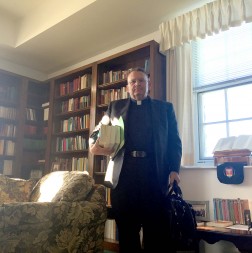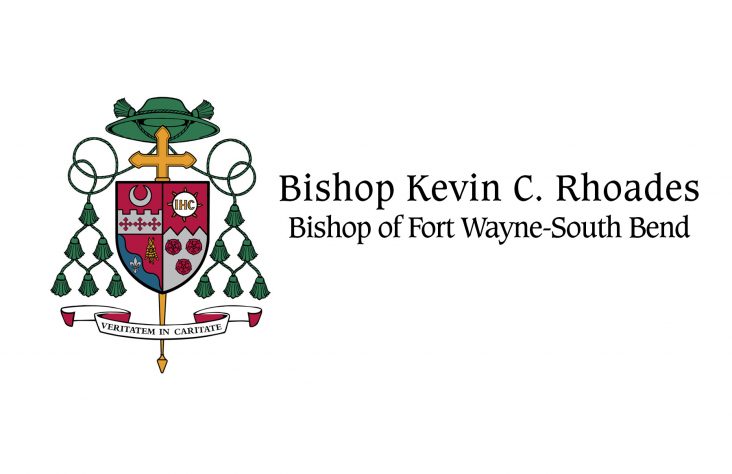October 26, 2016 // Local
Vocation Awareness Week: View from the Mount
By Msgr. Michael Heintz
 I arrived at Mount Saint Mary’s Seminary on Aug. 2, with a suitcase or two of clothes and about 40 boxes of books (and the words of the Gospel floating around the back of my mind: “Take nothing but a staff: no bread, no bag, no copper in your belt.”)
I arrived at Mount Saint Mary’s Seminary on Aug. 2, with a suitcase or two of clothes and about 40 boxes of books (and the words of the Gospel floating around the back of my mind: “Take nothing but a staff: no bread, no bag, no copper in your belt.”)
I spent the first week or two settling in. I was given a lovely suite of rooms on the third floor of McSweeny Hall, one of the oldest buildings on campus. It was a corner room with south and east exposure; as a morning person, I was delighted. Further, taking four flights of stairs multiple times daily has been good for me (my cardiologist and physician will be pleased)! Mount Saint Mary’s was founded in 1808, as the second oldest seminary in the nation; it is but 15 minutes south of the Gettysburg battlefield in Pennsylvania and about an hour northwest of Baltimore and Washington, D.C. It is set in the beautiful Catoctin Mountain range, on the northeast edge of the Appalachians. The seminary is situated on the campus of a small Catholic university, so there are both undergraduates and graduate students who share the campus. The seminary itself is a set of independent, free-standing buildings: McSweeny, Keating, Gallagher, and Mulcahy Halls. There are two beautiful chapels: St. Bernard, a smaller chapel (English Gothic) in McSweeny Hall, and the larger, Immaculate Conception Chapel (Romanesque), which serves the entire campus. Our own Bishop Kevin C. Rhoades served as rector here and is still remembered with great affection by many on the staff and faculty.

Mount Saint Mary’s Seminary in Emmitsburg, Md., welcomed more than 40 new seminarians, including three from the Diocese of Fort Wayne-South Bend, and another 80 returning seminarians this fall. “ Seeing in the early morning or afternoon, anywhere from 30 to 100 seminarians kneeling in silent prayer before the Eucharistic Lord, is deeply inspiring,” said professor Msgr. Michael Heintz.
There are over 40 men who were new to the seminary this year, including three new men from our own diocese, and orientation was almost a week-long affair. Much of that was spent introducing the new students to seminary life. The life here is structured around four pillars of formation — human, spiritual, intellectual and pastoral — as has been laid out in ecclesiastical documents since the landmark encyclical of St. John Paul II, Pastores Dabo Vobis, in 1992, which transformed the way seminary formation is done. The end goal of seminary formation is to produce priests who have integrated these aspects of their formation, allowing them to serve God’s people with energy, integrity, pastoral prudence and devotion. It aims to make them humanly balanced and accessible, pastorally sensitive and wise, intellectually sharp and spiritually deep. In addition to plenty of talks and opportunities for prayer during orientation, there were of course also lots of social and recreational events.
Including the returning seminarians, there are 120 men in residence here, representing the dioceses of Harrisburg, Baltimore, Arlington, Washington, Hartford, Norwich, Lafayette (both Indiana and Louisiana), Savannah, Atlanta, Hartford, Peoria, Wichita, Lincoln, Colorado Springs and Fargo; there are also two Oratorians, a Franciscan and a seminarian for the Congregation of the Resurrection. The Diocese of Fort Wayne-South Bend is well represented, and along with Harrisburg, they form the two largest contingents here. There are about a dozen diocesan priests who live and serve here as well, and they too are from all over: Washington, Baltimore, Arlington, Allentown, Metuchen, Harrisburg, Hartford, and Manchester, New Hampshire, as well as a Capuchin Franciscan and a priest from the Brotherhood of St. Charles Borromeo (the clerical branch of Communion and Liberation). Msgr. Andy Baker, from the Allentown diocese, who is about two years older than I, is the rector and a superb priest and role model for the men here. I must say, personally, that he has been wonderful to work with.
The day here is structured around prayer, personal and communal. There are two Holy Hours each day to accommodate the seminarians’ busy schedule: one, a simple Exposition, from 5:45-6:45 a.m. Morning Prayer and Mass follow at 7 a.m. There is solemn Exposition from 4-5 p.m., which concludes with Benediction. Then Evening Prayer is prayed. Dinner is served at 5:30. Each Monday and Wednesday, there is an optional Compline (Night Prayer) and rosary at 8 p.m. in the chapel, hosted and led each week by a different diocese represented here. While there are plenty of opportunities for prayer in community, diocesan priests often live alone and must inculcate the habit of praying the Divine Office personally, and to cultivate a capacity for intimacy with Jesus in silence.
While the seminarians share the food service and cafeteria on campus with the university students, they do have their own designated dining room, the Cardinal Keeler Dining Room. The priest faculty members have a dining room and we eat together most evenings; Thursdays we eat dinner with the seminarians in their dining room. There is a lounge with a television for the seminarians, and frequently there are sporting events and movies on weekends available for them to watch in common. In addition to the reading room at the seminary, which has a very good collection of theological works, the university has a library with a special Catholic Studies Room, a non-circulating room with an excellent collection of theological and philosophical works, as well as large windows gazing out over the campus and beyond to the mountains.
This semester, I am teaching Patrology (early Church history and theology) and Introduction to the Liturgy for the first-year theologians, as well as Christology to the third-year men. Next semester I will teach the capstone seminar for the fourth-year men, the deacons to be ordained priests, as well as a course in homiletics and an elective in Augustine’s City of God. I am also serving as a formation advisor, something like the role of mentor and guide, for six men and am spiritual director to 12 others.
I must say that I am deeply edified by the wholesomeness, decency and devotion of the seminarians here, and I am very grateful and privileged to work with them. Seeing in the early morning or afternoon, anywhere from 30 to 100 seminarians kneeling in silent prayer before the Eucharistic Lord, is deeply inspiring. They are young men who clearly and robustly love Jesus and his Church. And they are also quite well-rounded: A few weeks ago, they brought back the Vianney Cup as champions of an inter-seminary soccer tournament in Philadelphia. They are the kind of men you would want to minister to your children and grandchildren. You would be most proud of them. Please keep them in your prayers. And please continue to support the seminary education fund of the diocese. I can assure you that the money is well spent. These men are receiving a very fine formation here, and are an important investment in the future of the Church and of our own diocese.
I very much look forward to returning to the diocese over the Christmas holidays, as well as for the Chrism Masses and Holy Week. Be assured that one day each week I offer Mass for the Diocese of Fort Wayne-South Bend. Keep me, and all of us here, in your prayers.
The best news. Delivered to your inbox.
Subscribe to our mailing list today.






